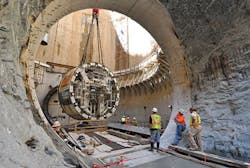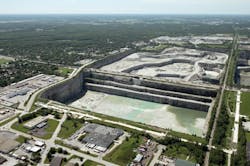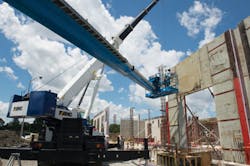Green Bonds: Are Your Projects a Good Fit?
By Sarah Fister Gale
If you want to generate more excitement about an impending water infrastructure bond program, consider going green. "Green Bonds" for water and wastewater infrastructure projects are a way for municipalities to let the investor community know that these bonds are going to fund environmentally friendly projects that will directly contribute to sustainability and climate change reduction in the community.
"It is a way to identify to the investor community who you are and what you do," said George Hawkins, general manager of the District of Columbia Water and Sewer Authority (DC Water). It helps municipalities attract a new cadre of investors who might otherwise ignore a water infrastructure bond program.
Hawkins's team made a 100-year taxable green bond offering last July, and within a few hours on the first day of sale, they had $1.1 billion in buy-orders, with $116 million from socially responsible funds that only invest in green initiatives. The huge level of interest allowed DC Water to extend the initial offering from $300 to $350 million and to lower their interest rate by 15 basis points, which saved rate payers $9 million. "It eclipsed all of our best case scenarios," Hawkins said.
DC Water isn't alone. Utilities in New York, Chicago, Massachusetts, and other areas have issued green bonds for water-related projects in the past year as a way to differentiate their offering, expand their investor base and increase competition for their bonds.
"It makes a lot of sense," said Sue Perez, executive director of the Massachusetts Clean Water Trust (MCWT), which issued $230 million in green bonds last December to fund clean water projects around the state. She noted that all of its projects are focused on clean water initiatives and usually include innovative technologies and strategies to improve energy efficiency, reduce waste and improve water quality. "We are green, and we've always been green," she said. "This is just a way to remind people what the Trust is all about."
To ensure that investors understood how their money would be used and to validate the greenness of the projects, MCWT listed descriptions of each project in the appendix of the offering documents, including the community where the project was located, environmental benefits it would bring to the community and who would be impacted. Then they aggressively marketed the green bond offering in the weeks leading up to the sale.
"Marketing is such an important part of this process," said Paul Palmeri, head of the public finance group at J.P. Morgan, the financial institution that underwrote the MCWT bond offering. "It helps you uncover buyers and market special features so you can grow your investor base." That's exactly what happened. "We picked up 8 to 10 new investors -- four of whom were new to JP Morgan," he said. "The green bond label helped us open our marketing to a new group."
Green Bonds Take Root
Green bonds were originally created by the World Bank as part of the "Strategic Framework for Development and Climate Change" to help stimulate public and private investment in projects that mitigate the impact of climate change or help affected people adapt to it. They were designed in response to rising investor demand for triple-A-rated fixed income products that support environmental initiatives, explained Betsy Otto, global director of the Water Program for Water Resources Institute in Washington, DC. "Green bonds have a lot of caché right now," she said. "They are drawing a lot of interest from investors who have set sustainability goals for their investments."
Initially, green bonds focused on major climate mitigation initiatives, like massive solar installations, offshore wind projects and irrigation efforts in water-scarce agricultural communities. But as their popularity surged, they expanded to include a broader category of endeavors -- including water and wastewater infrastructure projects, which align nicely with the goals of green bond programs.
The Metropolitan Water Reclamation District of Greater Chicago (MWRD) is another city group that has experienced great success with green bond offerings. The group issued a $297-million bond in December 2014, which included a variety of sustainably focused projects, including streambank stabilization efforts, construction of a phosphorus recovery facility and a capital improvements project to improve energy efficiency and eliminate air pollution at various facilities.
"We have always assessed the environmental benefits of our projects, so we thought it was a good time for us to enter the green bond market," said Mary Ann Boyle, treasurer for MWRD. "It expanded and differentiated our bond offering and how we present it to investors."
The green bond status did what she had hoped. MWRD doubled the number of investors vying for a piece of their bond offering in 2014 compared to their previous offering in 2011; and one-third of those investors were new to them. "It generated a lot of excitement," Boyle said.
Not Just a Label
Boyle was quick to note that going green required more effort than just slapping a green bond logo on the bond offering. There are currently no official standards or guidelines for what constitutes a green bond, but investors are looking for some level of accountability showing that investment will support projects with measurable environmental impact and how they will be kept abreast of the project accomplishments.
To accommodate the higher level of scrutiny, MWRD provided extensive detail about the projects in the offering documents, including plans for reporting on how funds are being spent and what impact the projects have on the environment once they are completed. They also involved engineers in all investor calls to answer technical questions about the projects. "We've never done that before, but it helped," Boyle said. "The investors asked a lot of detailed questions about the project outcomes, and the engineers are the best people to provide those answers."
Taking such additional steps to validate that projects are indeed green is a way to distinguish oneself in an increasingly crowded marketplace. While green bonds are still relatively new to the U.S. water and wastewater infrastructure industry, more green bonds are coming to market every day. The Climate Bond Initiative predicts that $100 billion worth of green bonds will be issued globally in 2015 -- up from less than $14 billion just two years ago.
As these financial vehicles become more common in the water sector, issuers will be expected to increase the level of transparency and reporting they offer as part of the exchange if they want to attract investor interest. "Today, a green bond means different things to different investors," said Perez. But that won't always be the case.
Standards on the Way
Right now, anyone can label a bond "green," and it's up to investors to decide whether it meets their sustainability standards. However, the market won't stay that way forever, said Sharlene Leurig, director of the water program for Ceres, a non-profit organization advocating for sustainability leadership. "The green bond market is getting flooded, and with some of these bonds, it is a stretch to call them green," she said.
To maintain the integrity of the label, Ceres, WRI and the Climate Bonds Initiative along with other industry groups are developing a voluntary Climate Bond Standard for water,which will help define what kinds of projects should be included in a green bond offering and what criteria investors and issuers can use to assess those projects. "We need to find a way to differentiate between projects that advance the cause of sustainability and mitigate the impact of climate change and those that just provide clean water," Leurig said. She expects the working group to have a draft of the standard ready for public comment this summer, and ideally they hope to have a completed standard by the end of the year.
While the standard will be voluntary, it will create a framework for investors to judge green bonds and give issuers a way to communicate about the sustainable features of their projects in terms that will make the most sense to the investor community.
"[Issuers] should be able to show demonstrable impact so investors can be sure that what they are buying will produce environmental benefits," said J.P. Morgan's Palmeri. For utilities interested in issuing their own green bonds, aligning with these standards today will ensure that their offering will stand out in a sea of lesser green bonds. It will also protect them from the risk of negative press for being green in name only, Leurig added. "This is one more way they can inspire the trust of their investors."
About the Author: Sarah Fister Gale is a freelance journalist based in Chicago, Ill. Over the last 15 years, she has researched and written dozens of articles on water management trends, wastewater treatment systems and the impact of water scarcity on businesses and municipalities around the world.
More WaterWorld Current Issue Articles
More WaterWorld Archives Issue Articles





